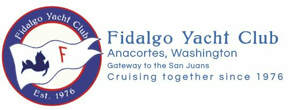“Part of the challenge of this crossing is the distance (just under 100 NM) between the two approved customs check-in locations: Prince Rupert and Ketchikan. Going north, the closest legal layover anchorage after leaving Canadian waters is Foggy Bay, and that is only if prior approval is obtained from US Customs and Border Protection in Ketchikan. This is about 60NM north and provides a suitably protected anchorage. However, entering the bay in a fresh westerly or southwesterly can be very rolly.” Fred Kaufhold
“One can check through Canadian Customs in Rupert at the Lightering Dock instead of having to travel all the way in to the Rowing Club or the new Marina at Cow Bay. This really saves time, and one avoids the slop caused by all the traffic at the fuel dock.” Eric Muller “Unfortunately, Nexus passes are no help in this neck of the woods. When arriving in SE Alaska from Canadian waters, we have to check in at customs in Ketchikan. If the seas turn to a washtub, and we’re already in US waters, we’ll contact Ketchikan customs for permission to stay in Foggy Bay until the seas settle down. (See next section for hidey holes.) From Alaskan waters returning to Canada, we have to check into Prince Rupert. We suggest than when at Prince Rupert’s lightering dock, if no one shows up, take a photograph so you have proof you were there.” Dave Wilshin “We always have several points identified that we can duck into should need be. We have only had to stop atDundas Island once. For our other three crossings we made the trip in one long day, leaving as early as possible. Also, Prince Rupert isn’t all that bad if you get stuck there; we were there for four nights on our first trip up. The website SlowBoat.com and Waggoner Cruising Guide each have good information covering the area.” Jim Perkins “We always have a Plan B, in case the weather unexpectedly turns. If we’re heading to Ketchikan, but still in Canadian waters, we plan to stop in either bay of Brundige Inlet on Dundas Island, or in Wales Harbour on Wales Island. Then we head to American waters from there when the seas improve. Or we know we can radio Ketchikan customs and get permission to stay in Foggy Bay. Our Plan B when heading south, but still in American waters is to either dodge into Foggy Bay or Nakat Harbor. Then we head to Prince Rupert when the seas calm down.” Dave Wilshin “If you can handle a long run, Hunt Inlet at the north end of Porcher Island is a good launching spot. Sometimes you can tie up at the government dock, but we usually go back through the narrow passage to anchor. If you walk down their path, you'll find some delightful surprises...like Eunie's quilting studio. The locals are very friendly.” Eric Muller “Our club maintains members’ SE Alaska passage itineraries. Heading into Ketchikan, they’ve departed from Foggy Bay, Prince Rupert, Dundas Island, and the north end of Porcher Island. Heading south to Prince Rupert, they’ve left from such diverse locales as Morse Cove and Judd Harbor on Duke Island, Gnat Cove, Kah Shakes, Foggy Bay, and Niblack Anchorage.” Joanne Wilshin
1 Comment
4/23/2019 10:39:10 am
Another must-read article for girding yourself with knowledge. Dixon Entrance can turn into quite the potato patch. Knowing where the hidey-holes are will make quite the difference in your experience.
Reply
Leave a Reply. |
About Us
Fidalgo Yacht Club is best known as a cruising club, whose members share a passion for boats, the Pacific Northwest inland waterways, and a sense of comradery. Safe boat handling is a priority. Summer will find us on the water from Anacortes to SE Alaska. Wintertime we gather together in our clubhouse to gather knowledge from dinner speakers and educational “bar chats”. We cruise and learn together and welcome new members whether a seasoned mariner or first-time boater. Categories
All
Archives
November 2019
|



 RSS Feed
RSS Feed